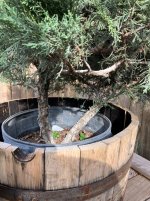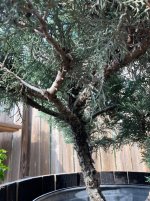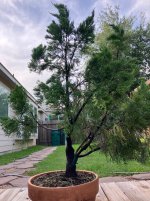Walther
Sapling









 Hello all,
Hello all,I recently obtained a hollywood juniper for very cheap so I couldn't pass up the opportunity for some practice material and I also found a very interesting tree from a Vietnamese nursery. The hollywood juniper had some work done to it already but was essentially abandoned which is why I got for cheap.
I wanted to ask those more experienced than me on what I should do in terms of the general design to go for with the trees and even specific designs that I should try and perhaps help me ID the species of one.
I think its a blue point but I am not sure.
Attached are pictures. I was thinking I should let it really just grow alot and then work on it but i think itd be better to seek the opinions of those more experiences than I.
The one in question is in a nursery pot inside half a jack daniels barrel.
Thank you all
